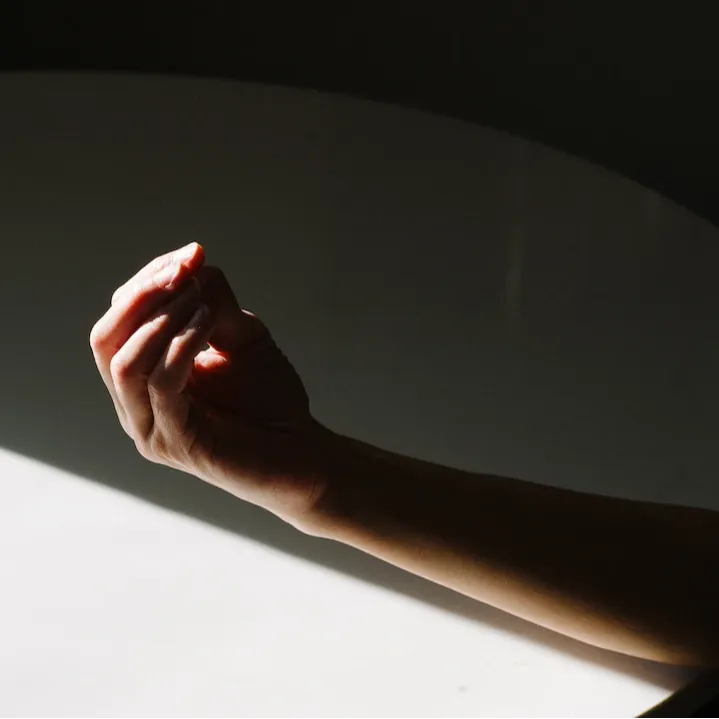Your Somatic Profile:
The Negotiator
Your nervous system has learned to respond to stress by running two opposing reflexes at the same time—protection and action.
Thomas Hanna* called this the “Dark Vise”: a somatic pattern where the body tries to brace and push forward simultaneously.
This often develops when life requires you to be both careful and productive, protective and proactive—at the same time.
*[Somatics by Thomas Hanna]

"I'm trying to keep it all together."
The Hidden Pattern:
Your body is trying to do two things at once: pull back to stay safe and move forward to stay functional.
The result? A chronic inner tug-of-war—conflicting muscle signals, compression in multiple directions, and a feeling of being both overactivated and shut down.
Over time, this pattern becomes wired into posture, breathing, and movement, leading to fatigue, stiffness, and a loss of freedom in your own body.
Why This Pattern Developed
Your Negotiator pattern likely developed from:
-
Major life transitions or ongoing uncertainty
-
Health changes, retirement, caregiving, or relocation
-
Multiple life demands happening at once
-
Long-term stress requiring you to “keep going” while staying cautious
-
A deep need to stay capable—while bracing for what’s next
- Internalized training habits from fitness, sports, or physical rehab—especially when combined with stress—can wire the system to hold both tension and action at once, creating a full-body sense of compression

How this shows up in your body sensations
- Feeling both hunched forward and tight in the back
- Restricted movement in multiple directions
- Difficulty finding a comfortable resting position
- Breathing feels limited in both chest and belly
- A sense of being restless and depleted at the same time
- Difficulty coordinating fluid or balanced movement

Common pain points and physical symptoms you may experience
- Chronic low back, pelvic, and extremity pain
- Stiff, rigid movements and reduced flexibility
- Arthritis-like symptoms or inflammation in joints
- Carpal tunnel, nerve impingement, or repetitive strain
- Pain in hands, wrists, elbows, feet, and knees
- Chronic fatigue that persists despite rest
- Hypertension or cardiovascular strain
- Muscle tone that feels both weak and tight
- Negative body image, especially around aging or physical decline

This double bind creates a body that feels compressed, stuck, and misaligned—not because of weakness, but because of conflicting internal instructions.
According to Hans Selye’s stress model, prolonged adaptation eventually leads to breakdown—not from failure, but from over-efforting without resolution.
The good news?
These patterns can be gently interrupted and reorganized.
THE TAKEAWAY

The Hidden Pattern
Your body is trying to do two things at once: pull back to stay safe and move forward to stay functional. A chronic inner tug-of-war—leading to fatigue, stiffness and loss of movement freedom.

What This Means:
You’re not broken—your system is trying to do the impossible.
You’re not lazy, unmotivated, or “falling apart.” You’re living in a nervous system that’s trying to protect and act at the same time.

Somatic Learning Goals
Learn to recognize the sensation of your dominant pattern. Decompress, Lengthen. Restore spatial 3-dimensionality. Mobilize body center. Upgrade function for posture, walking, pain relief.

If you often feel like “everything hurts,” that makes sense.
This isn’t just one issue—it’s the accumulation of patterns trying to solve opposite problems at once.
You may feel like nothing helps for long, or like your body is aging too fast.
But what’s really happening is chronic effort without resolution.
It’s neurological.
You didn’t cause this.
Your system adapted to your life demands as best it could—and now, with the right process, you can begin to unravel the tangle and restore order and ease.
Note:
This quiz draws on Hans Selye’s General Adaptation Syndrome, a widely recognized model of how the body responds to stress in three stages: alarm, resistance, and exhaustion. Chronic or unresolved stress may lead to long-term adaptations in posture, movement, and energy — patterns that can be updated through gentle, brain-based learning.
Now let’s help your brain learn something new.
You’ve just uncovered an important pattern in your nervous system—and now it’s time to take the next step.
Hi, I'm Adrienne and I've been a movement educator and clinical somatic practitioner for over 20 years.
In this short video, I’ll show you:
- Why these patterns develop (and why they stick around)
- How they affect your body, your energy, and even your emotions
- What it really takes to change them—gently, from the inside out
And I’ll introduce you to UNA-The 20 Minute Movement Makeover System, so you can start re-wiring your responses and moving with more ease—right away.
Click play to learn what your body has been trying to tell you—and how to finally respond with something that works.
Your Next Step: Try The Moovy Studio Membership
You don’t need to figure this all out—you just need to start where you are.
Inside The Moovy Studio Membership, you'll access the UNA 20 Minute Movement Makeover System, where you’ll experience gentle, brain-based lessons that help you decompress, re-coordinate, and rediscover your somatic intelligence—without strain or pressure.
Just 20 minutes can shift your entire experience of being in your body.
⇨Start your 10 day Guest Pass.
Gentle. Brain-based. Designed for you.
Start Your 10-Day Guest Pass

"I have noticed a better quality of movement when I look back over my shoulder when driving my car. Instead of just rotating my head/neck as in the past, I am now aware of movement through my trunk/spine to turn my body for a larger range of vision. This occurred spontaneously after doing lessons here."
-Elizabeth
"Many changes have happened, but mainly awareness - physical, emotional, and mental. Thank you for offering such beautiful work. "